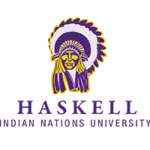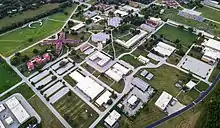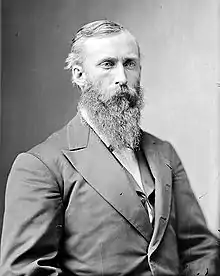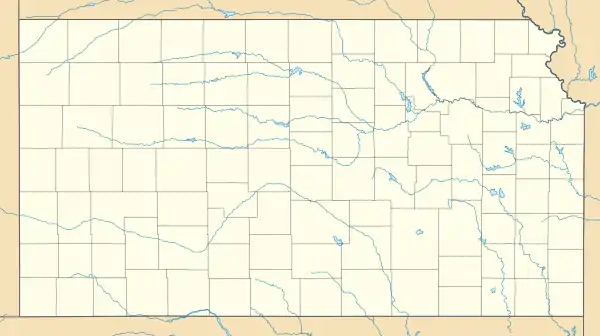Haskell Indian Nations University
Haskell Indian Nations University is a federally operated[1] tribal university[2] in Lawrence, Kansas. Founded in 1884 as a residential boarding school for American Indian children,[3] the school has developed as a North Central Association-accredited university that offers both associate and baccalaureate degrees.[4] The college was founded to serve members of federally recognized Native American tribes in the United States.
 | |
Former names | United States Indian Industrial Training School (1884–87) Haskell Institute (1887–1970) Haskell Indian Junior College (1970–93) |
|---|---|
| Type | Public tribal land-grant university |
| Established | 1884 |
Parent institution | Haskell Board of Regents |
Academic affiliations | AIHEC ACE CHEA Space-grant |
| Students | 1,000 |
| Location | , , United States |
| Colors | Purple and Gold |
| Athletics | NAIA – Independent |
| Nickname | Fighting Indians |
| Sports | 8 varsity teams |
| Website | haskell.edu |

Enrollment at the campus is nearly 1,000 students per semester, representing approximately 140 Tribal nations and Alaska Native communities.[5] Haskell is funded directly by the Bureau of Indian Education as a U.S. Trust Responsibility[6] to American Indian Tribes. While it does not charge tuition, students are responsible for paying yearly fees.[7]
Twelve campus buildings have been designated as U.S. National Historic Landmarks. Haskell is home to the Haskell Cultural Center and Museum,[8] the American Indian Athletic Hall of Fame,[9] the Indian Leader, the oldest American Indian student newspaper in the country,[10] and numerous student clubs and organizations.[11] Faculty and students built the Haskell Medicine Wheel Earthwork in 1992, and the Haskell-Baker Wetlands are important for migrating birds. The renowned Rinehart Collection is housed in the Haskell Cultural Center. Numerous sculptures and murals are located throughout the campus. Haskell also is a member of the American Council on Education, the Council for Higher Education Accreditation, the Higher Learning Commission, and the National Association of Intercollegiate Athletics.[12]
The university hosts cultural and academic events that attract visitors (both American Indian and non-Indian) from across the country and abroad. Such events include the annual Haskell Indian Art Market,[13] the Stories-n-Motion Film Festival,[14] and the Haskell Commencement & Pow-Wow.[15] These public events are held along with numerous educational conferences, workshops, and presentations.
History

The history of Haskell Indian Nations University reflects both U.S. Indian policy and self-determination efforts by American Indian and Alaska Native communities. Haskell was founded during an era when the federal government believed that Native Americans needed to assimilate into the majority culture in order to survive. To do this, the US government took Native American children from their families and sent them to Native American boarding schools to be educated.[16] In the late 19th century, the Carlisle Indian Industrial School, in Pennsylvania, was seen by many as the epitome of such a school, and so when the United States Congress decreed in 1882 that three new boarding schools should be made in Nebraska, Kansas, and Oklahoma (a plan that would cost $150,000), it was the Carlisle school that served as the model for these soon-to-be-constructed institutions, including Haskell. When Haskell opened in 1884, it went by the name United States Indian Industrial Training School.[17] According to many source, living conditions during the 1880s and 1890s were bad, and students were often physically punished if they failed to follow the rules of the institute.[18]

During the close of the 19th century, according to the university, the early trades for boys included tailoring, wagon making, blacksmithing, harness making, painting, shoe making, and farming, reflecting skills needed in their rural home environments. Girls studied cooking, sewing and homemaking. Most of the students' food was produced on the Haskell farm, and students were expected to work at the school.[5] In 1887, the school changed its name to Haskell Institute in honor of Dudley Haskell, the U.S. Representative from Kansas's 2nd district responsible for the school being located in Lawrence. Under a semi-military system, students wore uniforms, marched to classes and exercised regularly. A few years later, in 1889, Charles T. Meserve was appointed the fifth superintendent in Haskell's five-year history. His discharge of many employees (including the principal teacher) brought criticism from the president of the National Education Association, and his harsh treatment of the students caused them to send four protesting petitions to Washington. A Special Indian Agent, appointed to investigate the incident, whitewashed the whole situation.[19]
By the onset of the 20th century, Haskell had begun to evolve. During this time, after the school applied for and received accreditation as a Kansas high school in 1927, it became famous for its football teams.[20] During the 1960s, the civil rights movement encouraged many at the school to take the reins and reconfigure the school's pedagogical approach to better serve Indian country and Alaska Native communities.[3] In 1965, Haskell graduated its last high school class,[20] and two years later, the school became Haskell Indian Junior College.[20] In the late 1980s, planning began to develop the institution as a bachelor-degree granting university.[21] In 1993, the Assistant Secretary for Indian Affairs, Ada Deer, approved the aforementioned plan, and the institution was once again renamed Haskell Indian Nations University.[21] Haskell offered its first four-year baccalaureate degree program in elementary teacher education.[22] Within a few years, Haskell had developed its own, specialized bachelor's degree program in American Indian Studies;[23] Business Administration and Environmental Sciences degree programs soon followed.[24]
In 1994, the college was designated a land-grant college alongside 31 other tribal colleges.[25] At the turn of the 21st century, Haskell had become a tribal-based university with a curriculum serving general Native American and Alaska Native goals. Today, Haskell's alumni work in numerous areas to serve Indian country and Alaska Native communities.
Campus
Haskell Institute | |
.jpg.webp) Haskell's Tecumseh Hall (2018) | |
  | |
| Location | Lawrence, Kansas |
|---|---|
| Coordinates | 38°56′23″N 95°13′58″W |
| NRHP reference No. | 66000342 |
| Significant dates | |
| Added to NRHP | October 15, 1966[26] |
| Designated NHLD | July 4, 1961[27] |
.jpg.webp)
The Haskell campus has 12 buildings that have been designated as U.S. National Historic Landmarks. In addition to its historic architecture, Haskell is recognized for its collection of public sculptures, murals, photographs, and paintings.[28] Examples include the well-known sculpture, Comrade in Mourning, by Allan Houser.
The Haskell-Baker Wetlands span approximately 640 acres (260 ha) on the south side of the Haskell campus. These wetlands are home to 243 species of birds, 21 species of fish, 22 species of reptiles, and 26 species of plants. This area serves as a feeding and breeding ground for the migratory birds that breed in Canada and migrate to Mexico and South America. The Northern Crawfish Frog is an endangered species and its critical habitat is the wetlands.[29]
Blalock Hall
Constructed in 1978, Blalock Hall was named in honor of Margaret Blalock, Chippewa, a Haskell alumna, and long-time employee at the college, who was committed to serving the students at Haskell.[30] It is a residential hall for freshman (first year) men and male students transferring from other colleges and universities.[31]
Hiawatha Hall
.tif.jpg.webp)
Originally constructed in 1898 and dedicated on March 12, 1899,[32] Hiawatha Hall was named after the historic Onondaga leader of the same name. The hall was built by the United Methodist Church to serve as a campus chapel (although it has also served as a general auditorium and as a girl's gym at various times in the school's history),[33][34] and today it is the oldest building still standing on the Haskell campus.[32][33][35] Hiawatha Hall is currently owned by the federal government and has been closed for decades because the government has not allocated money to pay for necessary repairs—despite the building being on the National Historic Landmarks list.[36]
Osceola and Keokuk Halls
Osceola and Keokuk Halls are collectively known as "O-K Hall." Constructed in 1884, Osceola and Keokuk served as dormitories for men and women, respectively. Osceola was a famous Seminole warrior, whose name means "Rising Sun." Keokuk, a Sac and Fox whose name means "Watchful Fox," was not a hereditary chief, but recognized for his skillful leadership, force of character, and brilliant oratory.[30] O-K Hall is currently a residential hall for both women and men.[31]
Pocahontas Hall
Pocahontas Hall was built in 1931 and was named after the daughter of Powhatan, paramount chief of the Powhatan confederacy. She married English colonist John Rolfe, and they were ancestors to many descendants of First Families of Virginia.[30] It serves as a residential hall for freshman women and female students transferring from other colleges and universities.[31]
Pontiac Hall
Built in 1934, Pontiac Hall was named after an Ottawa chief. It is located immediately south of the main quadrangle.[33]
Powhatan Hall
Powhatan Hall was constructed in 1932 and named after the paramount chief of the Powhatan Confederacy, made up of 30 Algonquian-speaking tribes in coastal Virginia. Originally used for classrooms, it has been adapted as a residential hall,[30] housing Student Residential Assistants (SRS).[31]
Roe Cloud Hall
Completed in 1997, Roe Cloud Hall was named after Dr. Henry Roe Cloud, a member of the Winnebago Nation. He was the first American Indian superintendent of the Haskell Institute, serving from 1933 to 1935. Dr. Roe Cloud later served in the presidential administrations of Herbert Hoover and Franklin Delano Roosevelt. He was a spokesman for American Indian issues and education throughout his life.[30] It is a residential hall for both men and women.[31]
Sequoyah Hall
Sequoyah Hall was built in 1961 and named for Sequoyah, the Cherokee who developed a syllabary writing system for the Cherokee language in the early 19th century; this was the first known independent development of a writing system. It lies on the eastern edge of the main quadrangle area.[33]
Tecumseh Hall
Built in 1915 as a gymnasium, Tecumseh Hall was named after the Shawnee chief who led an effort to repulse the European-American settlers from Indian territory west of the Appalachian Mountains. It houses the Campus Shoppe, offices of the Student Senate, Student Activities, and the Indian Leader (the campus newspaper).[33]
Museums and libraries
Haskell is home to the American Indian Athletic Hall of Fame, which recognizes noted athletes such as John Levi, Jim Thorpe, Moses Yellow Hair, and Billy Mills.
The Haskell Cultural Center and Museum provides exhibits of interest about indigenous history. Its archives include collections on Haskell and aspects of Native American history.
Tommaney Library provides a range of academic research resources in print, online and digital form.
Haskell Medicine Wheel Earthwork
The Haskell Medicine Wheel Earthwork is located south of the campus. It was designed by Haskell professors, students, crop artist Stan Herd, and tribal elders, and dedicated in 1992 as a response to the 500th commemoration of the "Columbian Legacy".
According to the Haskell Catalog, the medicine wheel earthwork
symbolizes the scope and richness of indigenous cultures, from the beginning of humankind to the present. The circle is symbolic of the perpetual and sacredness of the spirituality of native peoples. The spokes are the four directions. The circle marks the astrological locations of the Summer and Winter solstice and represent the death, rebirth, balance and healing in Mother Earth. The bear claw represents the strength needed for the survival of indigenous people. The thunderbird located to the east represents the spiritual traditions of tribal people and points to the sacred circle and sacred fire contained within the Medicine Wheel Teachings.[37]
A replica of the medicine wheel is carved in the tile at the Haskell Cultural Center and Museum as a way of balancing the campus (with a medicine wheel on the north and south ends of campus).[38]
Organization
The University is one of 37 members[39] of the American Indian Higher Education Consortium, an organization of Tribal colleges and universities.
Academics

After earning an associate degree, many students transfer to the University of Kansas, other colleges, or join the workforce. Haskell offers four baccalaureate degree programs and four associate degrees in numerous subjects. The university received a #13 ranking on the 2010 "Top 50 Dropout Factory" list from Washington Monthly in their College Guide, with a graduation rate of 9%.[40]
Associate degree programs
Haskell offers associate of arts (AA) degrees in a variety of fields, including: Communication Studies, Liberal Arts, Media Communication, Para Professional Education, and Social Work. The school also offers associate of science (AS) degrees in: Community Health, Natural Sciences, and Recreation Fitness Management.[41]
Bachelor programs
The school also offers the four following bachelor programs:[12]
Indigenous and American Indian Studies (BA)
This program provides an integrated foundation of interdisciplinary knowledge and the practical skills needed to contribute to the development of Indigenous American Indian and Alaska Native communities and nations. The program is designed to prepare students for graduate or professional schools, or to enter the workplace after graduation.[42]
Business Administration (BS)
The School of Business offers the Bachelor of Science in Business Administration with emphases in management or tribal management. The management track emphasizes traditional academic study of contemporary management practices and theories common to the management of human, financial, technical, natural, and other resources. The Tribal Management track explores contemporary and historical issues that particularly affect management of tribal governments and enterprises.[43]
Elementary Teacher Education (BS)
Education majors complete a Bachelor of Science Degree in Elementary Education; they must pass the Principles of Learning and Teaching (PLT) and Elementary Education exam to be eligible to apply for Kansas provisional licensure to teach kindergarten through the sixth grade. Other states may have differing requirements.[44]
Environmental Sciences (BS)
This program provides a broad-based background to prepare students for graduate school or a career in environmental or biological fields. Courses offered include Biology, Ecology, Chemistry, Physics, Geography, Natural Resources, and Environmental Sciences.[45] It is intended to add substance to indigenous concerns about sustainability.
Student life
More than 20 student organizations and clubs on campus[11] provide students with chances to become involved in campus life and activities related to the larger community.
Athletics
Haskell (HINU) teams are known as the Fighting Indians and their team colors are purple, gold and white. The university is a member of the National Association of Intercollegiate Athletics (NAIA) competing as an Independent in all sports. Before July 2015, CCC competed in the Midlands Collegiate Athletic Conference (MCAC). Men's sports include basketball, cross country, football, golf, track & field, and cheerleading; women's sports include basketball, cross country, softball, track & field, volleyball, and cheerleading. The university has club sports in baseball and boxing.
Haskell had one of the best college football teams in the nation from 1900 to 1930.[46] Due to funding shortfalls, the football program was suspended beginning for the 2015 season.[47]
Notable people
- Evelyne Bradley - American Navajo judge[48]
- Emmett Bowles - professional baseball player[49]
- Chief Kenneth S. Clark Sr. - Nanticoke chief and Indian rights activist[50]
- Henry Roe Cloud - Tribal education advocate[51]
- Sharice Davids - American attorney, former mixed martial artist, politician serving as the U.S. Representative for Kansas's 3rd congressional district since 2019.[52]
- Larry Johnson - football offensive lineman in the National Football League[53]
- Buck Jones - professional football player[53]
- Nick Lassa - professional football player[53]
- Gilbert L. Laws - Nebraska Secretary of State and US Congressman[54]
- Mayes McLain - professional football player[53]
- Emmett McLemore - professional football player[53]
- Billy Mills - Olympic gold medalist in 10,000m at Tokyo 1964 Summer Olympics
- Joe Pappio - professional football player[53]
- Stan Powell - professional football player[53]
- Steve Reevis - Hollywood actor
- Pauline Small - first woman elected to a Crow Nation tribal office
- Jim Thorpe - Double Gold Medalist at the 1912 Olympic Games. Member of the Pro Football Hall of Fame, College Football Hall of Fame, US Olympic Hall of Fame, and the United States Track & Field Hall of Fame.
- Louis Weller - professional football player[53]
References
- "Colleges and Universities Archived 2015-05-08 at the Wayback Machine." Bureau of Indian Affairs. Retrieved on June 16, 2015.
- "About Tribal Colleges and Universities". AIHEC. Archived from the original on 2012-04-21. Retrieved 2011-09-03.
- "HINU Commemorates 125th Anniversary". DiverseEducation.com. June 1, 2009. Archived from the original on 2012-02-11. Retrieved 2011-08-29.
- "Haskell Informational Recruiting Video". Haskell.edu. Archived from the original on 2013-11-13. Retrieved 2013-11-12.
- "About Haskell". Haskell.edu. Archived from the original on 2012-05-18. Retrieved 2013-11-12.
- Slade, Lynn H. (May 20, 1999). "The Federal Trust Responsibility in a Self-Determination Era". findlaw.com. Retrieved 2013-11-12.
- "Our Value Equation". Haskell Indian Nations University. Retrieved May 24, 2018.
On-Campus Living: $715 ... Off-Campus Living: $240 [as of 2018]
- "The Haskell Cultural Center and Museum". Haskell.edu. Archived from the original on 2013-11-13. Retrieved 2013-11-12.
- "Official website". The American Indian Athletic Hall of Fame. Retrieved 2013-11-12.
- "The Indian Leader". Haskell.edu. Archived from the original on 2013-11-13. Retrieved 2013-11-12.
- "Student Life". Haskell.edu. Archived from the original on 2013-11-13. Retrieved 2013-11-12.
- "Haskell General Catalog" (PDF). Haskell.edu. Archived from the original (PDF) on October 7, 2012. Retrieved 2013-11-12.
- "Haskell Indian Art Market". Haskell.edu. Archived from the original on 2013-11-13. Retrieved 2013-11-12.
- "7th Annual Stories-n-Motion Film Festival". Lawrence.com. 2011-04-02. Retrieved 2013-11-12.
- "Haskell's Commencement & Pow-Wow". VisitLawrence.com. Archived from the original on 2013-11-13. Retrieved 2013-11-12.
- "ASU's Bibliography of Indian Boarding Schools: Approximately 1875 TO 1940". Asu.edu. 2013-11-08. Retrieved 2013-11-12.
- Kennedy, Frances (2008). American Indian Places: A Historical Guidebook. Houghton Mifflin Harcourt. p. 174. ISBN 9780395633366.
- Schwarz, Alan (May 11, 2013). "Overcoming Addiction, Professor Tackles Perils American Indians Face". New York Times. Retrieved September 29, 2017.
- Nelson, Donald F (2008). "Chapter 4". To the Stars over Rough Roads: The Life of Andrew Atchison, Teacher and Missionary. TidePool Press.
- "About Haskell, page 5" (PDF). Haskell.edu. Archived from the original (PDF) on September 16, 2012.
- "About Haskell, pp 5-6" (PDF). Archived from the original (PDF) on 2013-11-13. Retrieved 2013-11-12.
- "About Haskell". Archived from the original on 2012-05-18. Retrieved 2013-11-12.
- ""The American Indian Studies Program at Haskell Indian Nations University," in Indigenous Nations Studies Journal, 2.1, Spring 2001, page 77" (PDF). Retrieved 2013-11-12.
- ""University History" page 6" (PDF). Archived from the original (PDF) on 2013-11-13. Retrieved 2013-11-12.
- "NIFA 1994s The First 20 Years of the 1994 Land-Grant Institutions Standing on Tradition, Embracing the Future" (PDF). National Institute of Food and Agriculture. September 25, 2015. Retrieved December 20, 2020.
- "National Register Information System". National Register of Historic Places. National Park Service. January 23, 2007.
- "Haskell Institute". National Historic Landmark summary listing. National Park Service. Archived from the original on 2009-06-15. Retrieved 2008-04-07.
- Henning, Sarah (2011-04-29). "Haskell Artwork". .ljworld.com. Retrieved 2013-11-12.
- "Wetlands Protection Organization". Haskell.edu. Archived from the original on 2013-11-13. Retrieved 2013-11-12.
- "University Residency Halls, p. 19" (PDF). Archived from the original (PDF) on 2013-11-13. Retrieved 2013-11-12.
- "Housing." Haskell Indian Nations University. Retrieved on June 16, 2015.
- Armitage, Katie (2010). Lawrence: Survivors of Quantrill's Raid. Mount Pleasant, SC: Arcadia Publishing. p. 103. ISBN 9780738577999. Retrieved May 24, 2018.
- "A Walking Tour of Haskell Indian Nations University" (PDF). Haskell Indian Nations University. Retrieved September 29, 2017.
- Federal Writers' Project of the Work Projects Administration for the State of Kansas (1949). Kansas: A Guide to the Sunflower State. Hastings House. Retrieved May 24, 2018.
- Brockington and Associates (2001). "Appendix C. Buildings on the Haskell Indian Nations University Campus" (PDF). Archived from the original (PDF) on April 11, 2019. Retrieved September 29, 2017.
- Hendricks, Mike (October 6, 2015). "Haskell hopes for independence as campus mires in disappointment". Kansas City Star. Retrieved September 29, 2017.
- ""Medicine Wheel" in the Haskell General Catalog, page 6" (PDF). Archived from the original (PDF) on 2013-11-13. Retrieved 2013-11-12.
- "Medicine Wheel". Haskell.edu. Archived from the original on 2013-11-13. Retrieved 2013-11-12.
- "Tribal College and University Roster". Aihec.org. 2013-10-22. Archived from the original on 2013-11-12. Retrieved 2013-11-12.
- "2010 Dropout Factories". Archived from the original on August 25, 2010. Retrieved September 2, 2010.
- "Associate Degree Programs". Haskell Indian Nations University. Retrieved October 2, 2017.
- "Course Catalog, page 76" (PDF). Archived from the original (PDF) on 2013-11-13. Retrieved 2013-11-12.
- "Course Catalog, page 77" (PDF). Archived from the original (PDF) on 2013-11-13. Retrieved 2013-11-12.
- "Course Catalog, page 92" (PDF). Archived from the original (PDF) on 2013-11-13. Retrieved 2013-11-12.
- "Course Catalog, page 68" (PDF). Archived from the original (PDF) on 2013-11-13. Retrieved 2013-11-12.
- Schmidt, Raymond (May 2007). "Shaping college football: The transformation of an American sport, 1919-1930". ISBN 978-0-8156-0886-8. Cite journal requires
|journal=(help) - http://www2.ljworld.com/news/2015/may/21/haskell-suspends-football-program-2015-season/
- "Evelyne E. Bradley". Arizona Journal. Retrieved January 30, 2014.
- "Emmett Bowles", Wikipedia, 2019-10-07, retrieved 2020-01-10
- "Former Nanticoke chief dies". Delaware Online, The News Journal. Retrieved October 15, 2015.
- "ROE CLOUD, HENRY (1884-1950)". Encyclopedia of the Great Plains. Archived from the original on 2014-03-25. Retrieved January 30, 2014.
- Sharice Davids edges Brent Welder for Democratic nomination, will face Kevin Yoder in fall; Shawnee Mission Post; August 8, 2018.
- "NFL Players who attended Haskell Indian Nations University". databaseSports.com. Archived from the original on March 7, 2008. Retrieved January 30, 2014.
- "LAWS, Gilbert Lafayette, (1838 - 1907)". Biographical Directory of the United States Congress. Retrieved January 30, 2014.
External links
| Wikimedia Commons has media related to Haskell Indian Nations University. |